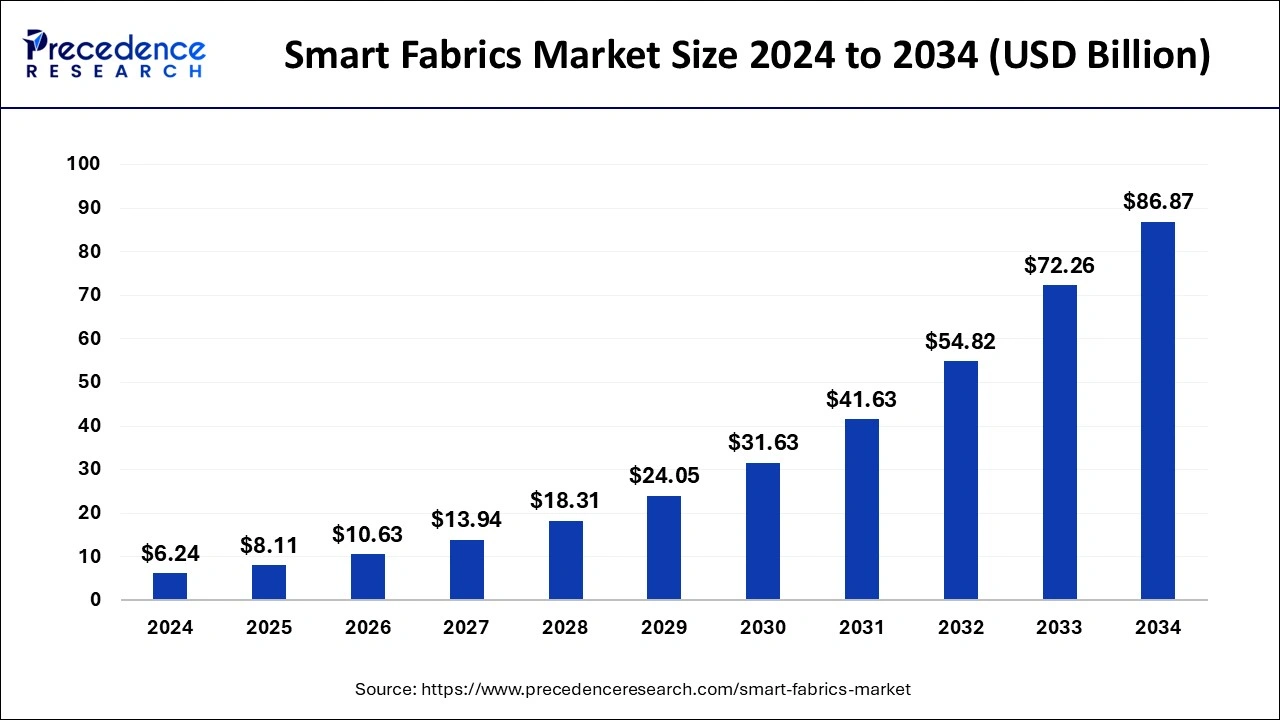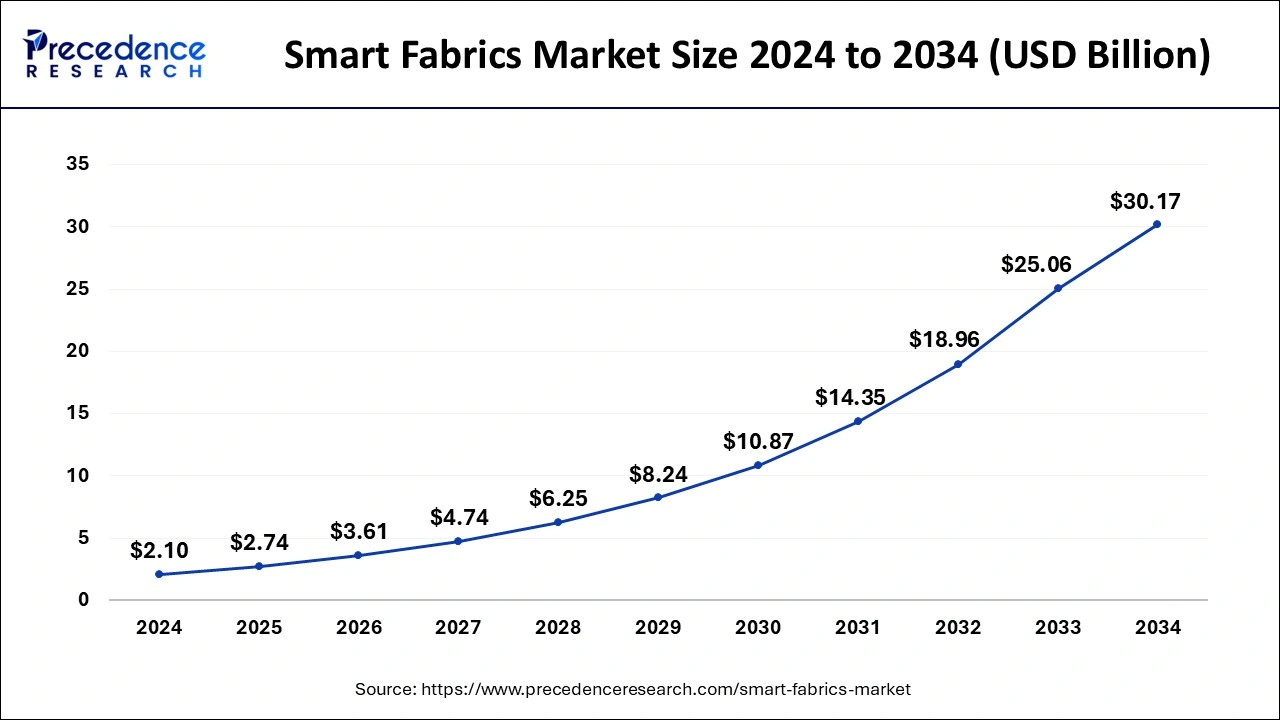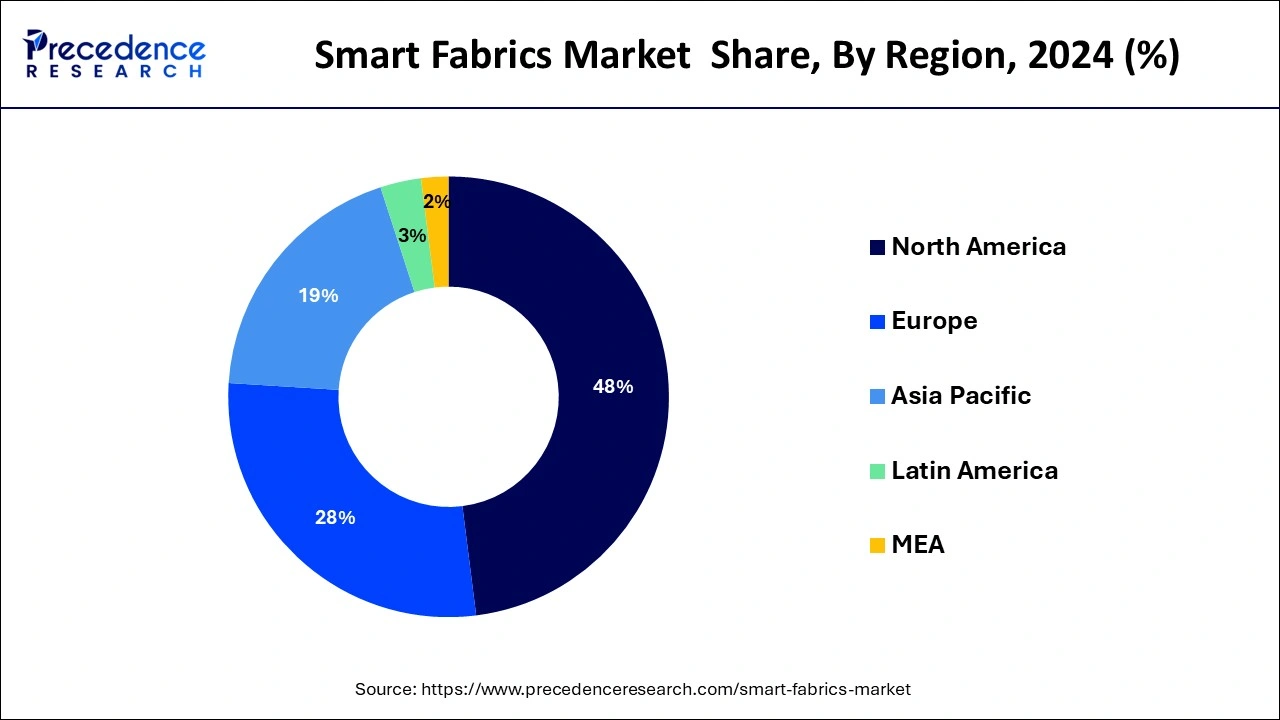October 2024
The global smart fabrics market size is calculated at USD 8.11 billion in 2025 and is forecasted to reach around USD 86.87 billion by 2034, accelerating at a CAGR of 30.13% from 2025 to 2034. The North America smart fabrics market size surpassed USD 3.00 billion in 2024 and is expanding at a CAGR of 30.15% during the forecast period. The market sizing and forecasts are revenue-based (USD Million/Billion), with 2024 as the base year.
The global smart fabrics market size was estimated at USD 6.24 billion in 2024 and is predicted to increase from USD 8.11 billion in 2025 to approximately USD 86.87 billion by 2034, expanding at a CAGR of 30.13% from 2025 to 2034.

The U.S. smart fabrics market size was valued at USD 2.10 billion in 2024 and is anticipated to reach around USD 30.17 billion by 2034, poised to grow at a CAGR of 30.54% from 2025 to 2034.

North America dominated the smart fabrics market, holding the largest share of 48% in 2024, and is projected to be the fastest-growing region market. The region is home to several prominent companies operating in the smart fabric industry, which contribute to the market's growth by developing, manufacturing, and marketing smart fabric-based products. The presence of established players fosters product innovation and market competitiveness. North America boasts a robust technological infrastructure and expertise, facilitating advancements in smart fabric technologies.

Asia Pacific is also expected to witness steady growth at a CAGR of 38.4% during the forecast period. The region benefits from the availability of low-cost raw materials and labor in countries like China, Japan, and India, establishing it as a manufacturing hub for smart fabric technology. This trend has resulted in a decline in overall smart fabric production in the European region. However, the European Union's sponsorship of an increasing number of R&D activities for intelligent fabrics within programs like EU FP6 and FP7 is revitalizing the industry in European countries.
A textile is traditionally defined as an object created through the weaving of threads or yarns into fabric, typically made from natural fibers derived from plants or animals. However, with advancements in technology, textiles have evolved beyond traditional forms. Laboratory manufacturing has led to the production of textiles that are stronger and more versatile than their natural counterparts.
In contemporary times, textiles are not limited to conventional materials, as innovative technologies have introduced new possibilities. Modern textiles incorporate thin fibers that can transmit data, creating a seamless integration with digital communication devices. This technological integration has given rise to the smart fabrics market, where computer-based technology is woven into the fabric itself. As a result, textiles are no longer just passive materials but have become dynamic, interactive components that can serve various functions beyond their conventional roles.
| Report Coverage | Details |
| Growth Rate from 2025 to 2034 | CAGR of 30.13% |
| Market Size in 2025 | USD 8.11 Billion |
| Market Size by 2034 | USD 86.87 Billion |
| Base Year | 2024 |
| Forecast Period | 2025 to 2034 |
| Segments Covered | By Product, By Function, and By End Users |
| Regions Covered | North America, Europe, Asia-Pacific, Latin America, and Middle East & Africa |
Advance technologies in smart fabrics
The textile industry has undergone a transformation with the advent of new technologies, particularly artificial intelligence (AI) and the Internet of Things (IoT). Smart apparel is now being manufactured, incorporating AI, Bluetooth Low Energy (BLE), edge computing, and cloud data, enabling the monitoring and communication of the wearer's vital information such as blood pressure, heart rate, perspiration, and temperature. AI plays a crucial role in accessing and collecting historical and real-time operational data, providing insights that enhance the wearer's efficiency.
In textile manufacturing, AI applications include defect detection, pattern inspection, and color matching. The integration of AI enables the production of smart apparel that leverages IoT and electronic sensors, creating an enhanced user experience. This technological integration not only ensures comfort but also focuses on health-related features. Smart fabrics, covering a significant portion of the body, can potentially provide various types of physiological information. Additionally, smart fabrics rely on BLE and IoT technologies for a durable energy source from embedded batteries.
Additionally, the development of clothes and fabrics equipped with groundbreaking technology, capable of monitoring every movement and facilitating the recycling and reuse of textiles, is anticipated to be a key driver for the market in the forecast period. Technological advancements in the wireless and electronics segment have led to the miniaturization and integration of electronic components into conductive textiles, fostering market growth.
The increasing integration of Bluetooth Low Energy (BLE) technology, offering features like low power consumption and multi-vendor interoperability, will also contribute to market expansion. Attires equipped with BLE technology have the ability to sense, feel, and transmit data, provided the device is connected to the internet. The growing popularity of sophisticated gadgets with advanced functionalities, including sensing and reacting to the surroundings, is expected to propel the market. These fabrics incorporate components such as actuators, controllers, and sensor units for effective operation, making them valuable for protection and safety in applications like consumer wear and military attire.
Lack of standards and regulations
The lack of standardized regulations poses a significant obstacle to market growth, making it challenging for smart fabric manufacturers to scale up and commercialize new technologies. The production processes involved in smart fabrics can result in environmental and health hazards. Operations such as de-sizing, bleaching, dyeing, neutralizing, scouring, mercerizing, printing, and finishing in the textile industry generate high-level toxic effluents, contributing to soil contamination and air, groundwater, and surface water pollution. Establishing environmental standards becomes crucial to control and mitigate the pollution caused by the textile and leather industries. The implementation of robust standards and regulations is essential to ensure the sustainable and responsible production of smart fabrics.
Growing demand for soundproof transportation
The contemporary trend of individuals owning multiple mobile devices, including smartphones and tablets, has spurred the demand for compact devices that can integrate computing and monitoring functions into a single device. This trend creates opportunities for the development of multi-function and hybrid smart fabrics, providing users with convenience and convergence in wearable devices. Researchers from the National University of Singapore (NUS) exemplify this by incorporating conductive textiles into clothing, establishing a wireless body sensor network. This network enables several wearable devices to dynamically connect at once, transmitting data with signals 1,000 times stronger than conventional technologies. The application of such smart fabrics extends to human-machine interfaces, health monitoring, and medical interventions.
The development of multi-featured and hybrid smart fabrics is a notable trend in the smart fabrics market. With the increasing prevalence of individuals owning multiple mobile devices such as smartphones and tablets, there is a growing demand for compact and integrated solutions that can consolidate various computing and monitoring functions into a single device. Hybrid smart fabrics leverage advanced technologies to seamlessly integrate multiple functions, providing users with convenience and versatility.
The applications of multi-featured and hybrid smart fabrics span various sectors, including human-machine interfaces, health monitoring, and medical interventions. This trend reflects the industry's efforts to meet the evolving needs of consumers for integrated and technologically advanced wearable solutions.
The active segment led the market with a 44% market share in 2024. The smart fabrics market exhibits distinct segments, each catering to specific applications and functionalities. The active segment, encompassing sports and fitness-related fabrics, such as workout clothing, sports bras, fitness bands, and running shoes, commands the largest market share. Smart fabrics in this category provide performance-enhancing features such as moisture-wicking, temperature regulation, and compression, contributing to improved athletic performance and comfort during physical activities.
The very smart product segment is poised to experience the fastest CAGR of 38.2% in the forecast period of 2025-2034. This growth is attributed to continuous advancements in sensor technology, conductive materials, and the miniaturization of electronic components integrated into smart fabrics.
While, passive smart fabrics, which can sense the user's movement and environment, are expected to undergo significant expansion. These fabrics offer functionalities at a lower price point and are less complex than other variants. The very smart fabric, characterized by its ability to sense, react, and adapt based on given circumstances, aligns with principles of artificial intelligence (AI). Its capability to effectively respond to life-threatening situations or maintain high comfort levels during extreme environmental changes is anticipated to drive its growth.
The sensing segment dominated the smart fabrics market with a 38% share in 2024, underlining its crucial role as the primary attribute of smart garments. Sensing fabrics are equipped with sensors capable of detecting and measuring various physical attributes like temperature, pressure, moisture, and movement. These fabrics find applications in sports and fitness monitoring, healthcare, and military sectors.
The energy harvesting segment is anticipated to exhibit the fastest CAGR of 32.9% during the forecast period. Fabrics in this category are designed to capture and store energy from the surrounding environment, such as solar or kinetic energy. The stored energy can then be utilized to power electronic devices or sensors integrated into the fabric, enhancing the fabric's functional capabilities.
The defense & military segment dominated the smart fabrics market with a 29% market share in 2024. This sector is actively exploring the use of smart fabrics for various applications, including soldier protection systems, body monitoring, and communication. The lightweight and flexible nature of smart fabrics makes them well-suited for defense and military applications, where mobility and comfort are critical. Integrating these fabrics with electronic components provides a lightweight alternative to traditional garments with heavy batteries. Warrior systems are expected to incorporate wireless weapons, chemical and biological threat detectors, heads-up displays, global positioning systems (GPS), and battery power to enhance safety.
The sports & fitness segment is projected to witness substantial growth at a CAGR of 34.8% during the forecast period. Smart fabrics, capable of reacting to mechanical, thermal, magnetic, chemical, and electrical stimuli, are employed in advanced electronic devices like fitness watches and belts for real-time health and body vitals monitoring. Additionally, smart fabrics are utilized in medical applications to accelerate recovery times. The increasing global population's demand for improved healthcare and medical facilities contributes to the market's growth in this segment.
By Product
By Function
By End Users
By Geography
For inquiries regarding discounts, bulk purchases, or customization requests, please contact us at sales@precedenceresearch.com
No cookie-cutter, only authentic analysis – take the 1st step to become a Precedence Research client
October 2024
January 2025
September 2024
March 2025